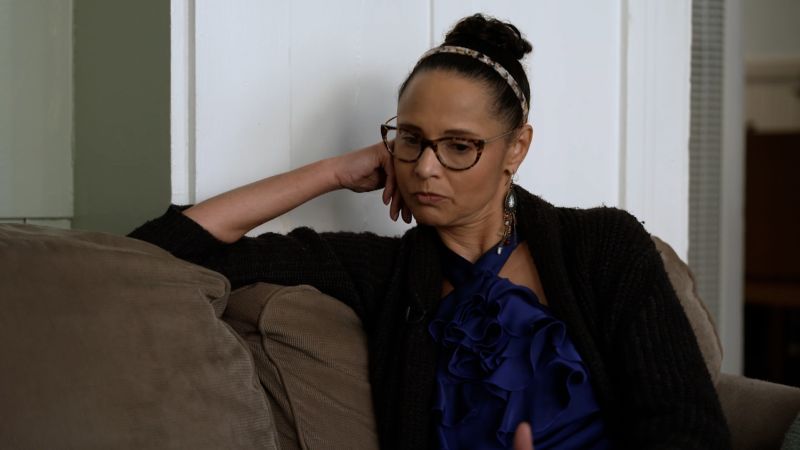A mother was raising her son in a city she loved. Then San Francisco changed and stole her boy
Watch how drugs, homelessness and crime have changed a city, and what is being done about it. CNN’s Sara Sidner asks “What Happened to San Francisco?” on “The Whole Story with Anderson Cooper,” Sunday at 8 p.m. ET.
San Francisco CNN —
Tanya Tilghman moved to the Bay Area as a teenager to live with her mom. Later, she married, had two sons and made a home in San Francisco’s historically Italian North Beach district, up the hill from the tourist and financial centers.
Even when her marriage broke down, she never thought of leaving. This was her city, her people. Liberal like her, with a mix of income levels and a general sense of community. She didn’t worry about her growing boys going out on the streets where she herself always felt safe.
But those streets have changed, she says. She believes policies from City Hall and even groups who advocate for the homeless have exacerbated some of the problems and the community she once felt a part of has gone, she says. And her son got caught up in a scene you can almost not avoid in the city: the drug scene.
Tanya Tilghman says jail and rehab may finally help her son. CNN
Roman Vardanega first tried illegal drugs at the start of high school, Tilghman said, taking a prescription medication at a friend’s house.
He quickly became hooked, his mother said, moving on to cocaine, heroin and later fentanyl, all available in the city’s seedy Tenderloin area.
Tilghman admits she was uneducated about the prevalence of hard drugs, even naïve. But it was not something she encountered every day. Back then “I think it’s a lot worse now than when I was growing up here,” she said. “We used to come to the Tenderloin when I was a teenager because we thought it was just kind of fun, edgy and I never as a teenager felt unsafe. But I also don’t remember people coming up to me and asking me if I want to buy drugs.”
One of her first clues that her son was getting in deep was when she was with him on a tour outside City Hall while he was in high school. It was a few blocks from the Tenderloin and some of the unhoused people on the street knew him by name, as if he spent a lot of time out there with them – which is what he was doing, scoring his drugs.
She tried to help. Vardanega spent the 11th grade in rehab but persuaded his mom to let him return. She welcomed him home, but so did the streets.
Roman Vardanega showed musical talent from a young age, his mother said, before his addictions consumed him. Courtesy Tanya Tilghman
By then, her neighborhood had changed, with drugs seemingly freely available, even just heading home on the Bay Area Rapid Transit (BART) local transport system.
“When I got out of the BART station, the first thing that I was asked is if I wanted to buy drugs,” Tilghman said. The ease of getting and using drugs made the city a dangerous and sometimes deadly playground for people like her son.
Vardanega started to live on the streets full-time when the Covid pandemic hit in 2020. The city shut down, residents either left or stayed inside and at the height of the pandemic, more people died of drug overdoses than Covid-19.
“All the tents started going up in the city,” Tilghman said. “The open-air drug market became a lot worse. And so it became easier for him to buy drugs and to use it out in the open.”
And confusingly to Tilghman, the city just seemed to look away.
“The city’s policies have absolutely hurt my son, has hurt us, and has caused him to, I would say go into his addiction even a lot more,” she said.
“If you got busted with drugs, most likely you’re not going to jail, the police officers would just let you go,” she said. “That made the situation a lot worse, especially for my son because he’s really young, and still kind of in that party state of mind.”
Tilghman’s state of mind was focused on one goal: finding her son. She knew he was an addict. She knew she loved him so much it hurt. And she knew she would not stop searching until she found him even if that meant putting herself in danger.
She would walk the streets looking at things most people try to avoid, looking directly into the eyes of the people living on the streets. Sometimes she got back blank stares. Other times a sympathetic ear or a hopeful hint about where her son might be.
She didn’t find him, but so many people were like him. “What makes me sad is that I see my son’s face in everybody’s faces … out on the streets,” Tilghman said.
As Covid descended, many housed residents began disappearing and the tent cities exploded onto the sidewalks, along with the drugs, the addictions and signs of mental illness.
Rectangles are painted on the ground to encourage homeless people to keep social distancing at a city-sanctioned homeless encampment across from City Hall in San Francisco in May 2020. Josh Edelson/AFP via Getty Images
Mayor London Breed declared a state of emergency in the city, to include a “linkage center” in the Tenderloin, promoted as a place where addicts could get services to help them.
When it opened in January 2022, Tilghman was hopeful it could be somewhere her son would find himself, and one day she went to take a look. When she got there, she heard music blaring and tried to get a look inside.
“I saw people doing drugs. I couldn’t believe it. I’m like, this is a place where people are supposed to get help. And they’re actually doing drugs?” Tilghman said.
A little later, she posed as an addict and went to the center for a closer look.
“I said to them that I wanted to get off drugs, and that I needed help,” she said. “And they laughed at me. And the guy at the door said, ‘We can help you do drugs. But if you want help getting off drugs, you’re gonna have to come back tomorrow’,” Tilghman said.
The center had what was supposed to be an area where overdoses could be treated, but it became known as a place to take drugs, not seek other services.
“The most upsetting thing … was that the harm reduction area was more like a party scene,” Tilghman said. “If my son were to go there wanting to access services, him being addicted to drugs, if he were to see a party scene with people dancing and singing and doing drugs, and most likely selling drugs inside, there’s just no way he would access services. Because he would get so distracted, and be so triggered that he would go and use.”
The city’s laissez-faire philosophy had just gone too far, she felt.
“When you could walk into a store and steal under $1,000 worth of merchandise and get away with it – that’s going way too far,” she said. “It’s going too far when you could smoke crack in front of a police officer and the police officer just looks at you and doesn’t even arrest you.”
The struggle to try to save her son wore her down. Not once, but three times Tilghman says she got so low and so hopeless she attempted suicide.
The situation is beginning to change, both for Tilghman personally, and perhaps her city.
The Tenderloin Linkage Center, which was later renamed to just the Tenderloin Center, closed last December. Tilghman has found new support and a mission working with Mothers Against Drug Addiction and Deaths. A new district attorney took over after the previous one was recalled by voters who perceived him as soft on crime. Tilghman’s son Vardanega got in trouble with the law, served jail time and was sent to a court-mandated rehab program.
Incarceration is a good thing for him in Tilghman’s mind – keeping him alive, off the streets and giving him a chance in a treatment program.
San Francisco is still beautiful to her – with the Golden Gate Bridge, the Presidio and Fisherman’s Wharf, the Italian enclave of North Beach. But it has become scarier, and she feels some of the blame has to go to politicians whose job it is to clean up the streets.
“I’m liberal,” Tilghman said. “My politics have stayed the same and things have gone crazy around me.”
Source: CNN


